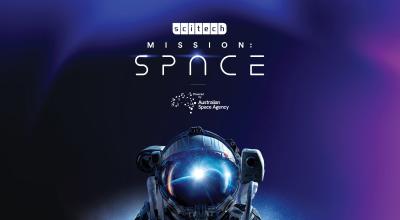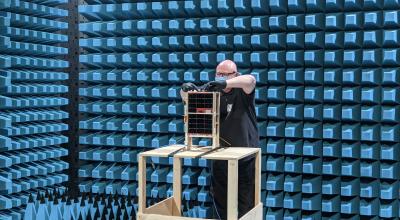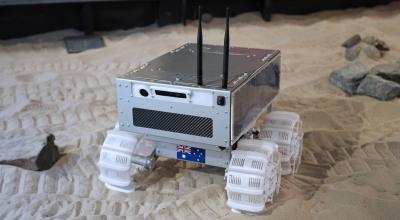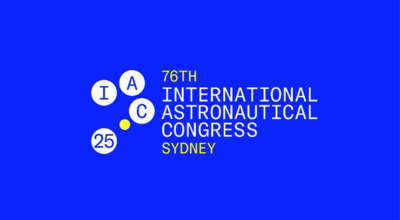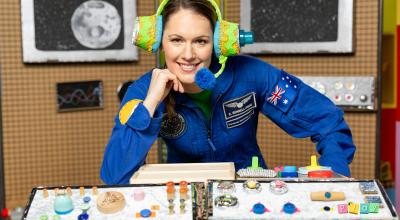Introduction and acknowledgements
Good morning, everyone.
It’s a pleasure to be here today for the 2023 SIAA Southern Space event.
Thanks to James, and the Board and team at SIAA for bringing us together here in Canberra.
I’d like to start by acknowledging the traditional owners of the land on which we meet today, the Ngunnawal people, and I pay my respects to their elders past and present. And I extend that acknowledgement to any First Nations people here today.
I’d also like to acknowledge fellow keynote speakers Lieutenant General John Frewen and His Excellency Mark Glauser, High Commissioner for Canada in Australia.
Since Joint Capabilities assumed the space domain and Space Command in July, Joint Capabilities and the Agency are proudly working together to identify further synergies and opportunities to collaborate in a domain that is dual use, building on the relationship we’ve had with Space Command for a few years now. Thanks to JJ and AVM Catherine Roberts for their support and partnership.
Canada is a good friend of Australia, and Your Excellency I applaud you and your team including Ms Carolyn Huber who have done much to bring the nations together in space.
I remember standing here last year at the second Southern Space event delivering the keynote.
A lot has happened since then, that’s probably an understatement, a lot of good has happened.
To that end, I want to reflect on a few key moments from 2023 and why I remain inspired by the work you do and remain confident, as should you, on the future of Australia’s space sector.
The challenges and successes of 2023
It is timely that we are here together as we approach the end of 2023.
Change and uncertainty can be difficult to navigate regardless of whether you work in industry, government or academia. We’ve experienced it as an Agency, and I know it’s been felt across the entire sector.
The 2023-24 Federal Budget provided funding for the Agency to maintain its core functions and the continuation of several of our programs, including the main elements of the successful Moon to Mars program and the International Space Investment India Projects.
Although several programs were not continued, notably the National Space Mission for Earth Observation – we need be considerate of the broader context of fiscal repair, that the criticality of space-based services and data has not changed but only enhanced and put our energy into focusing on the long game.
I remain focussed and confident about the future of what space can do for the nation and what we can achieve over the coming years, for 3 main reasons.
One. Working together, we have created the conditions for the sector to grow and succeed.
Shortly I’ll reflect on where we are five years on from the formation of the Agency – the contrast is dramatic, pre-and post-agency in Australia.
Our programs have provided seed funding to companies that have gone on to achieve impressive results in their own right.
For example, Fleet Space Technologies secured $50 million in Series C funding this year to continue scaling its ExoSphere technology.
The Agency is proud to have helped Fleet incubate this technology under our Supply Chain Program with an initial investment under $400,000 that has helped generate tens of millions of dollars of revenue and is helping drive Australia’s transition to clean energy through identifying critical mineral deposits in a less environmentally invasive way.
We are seeing those significant multiples for return on investment for every space dollar invested that His Excellency Mark Glauser articulated well earlier.
Two: International partnerships created and nurtured by the Agency have opened doors to new opportunities for the sector.
For example, this year our own space agent, Katherine Bennell-Pegg, was named as the first person to train as an astronaut with an international space Agency under the Australian flag.
This is elevating Australia’s standing on the global stage through stronger space cooperation with Europe, while also bringing home valuable insights and knowledge to shape opportunities in aerospace medicine, microgravity science and human spaceflight.
But most importantly, Katherine’s experience is helping influence greater diversity and interest in STEM by inspiring more Australians to enter STEM-related careers.
And finally, three. The criticality of space for the nation is increasingly becoming part of Australian discourse. This is no small feat and is enabled by the collective achievements of the sector.
For example, Advanced Navigation’s new robotics facility for autonomous systems at the University of Technology Sydney, opened by Minister Husic last month, will scale up the manufacturing of its AI navigation technology that will help lunar landers touch down on the Moon’s surface.
With critical technologies such as robotics and quantum being key priorities for the Australian Government, Advanced Navigation is demonstrating the leading role space plays in enabling these technologies and making them more sophisticated.
Another example is Skykraft successfully launching the largest Australian-made payload into space in January.
Their space-based service will change the game for the global aviation industry, helping address gaps in surveillance and communications over remote areas.
There is an important link between the wider community becoming more aware of the criticality of space, and investments in the sector continuing to grow.
Sydney based HEO Robotics raised $12 million in Series A funding this year. Their Holmes Imager also successfully launched as part of SpaceX’s Transporter-8 mission.
The telescopic space camera is the world’s first, and 100% Australian made, commercial camera dedicated to non-Earth imaging. Holmes is advancing the inspection of in-orbit satellites by allowing us to monitor space objects with greater clarity.
Through the $180 million iLAuNCH program, Australia is building its sovereign space capability through investment in industry research, commercialisation, and manufacturing.
The iLAuNCH research hub at the University of Southern Queensland has officially opened. It is home to critical space infrastructure, such as a long-duration hypersonic tunnel, advanced automated composite manufacturing facilities, and a rocket solid fuel manufacturing lab.
In 2023 alone, SmartSat CRC has invested $7 million to support ACT’s Space Update – injecting funds into research for space technologies to address bushfire resilience, spacecraft system autonomy, and space object surveillance.
This follows earlier investments of $1 million in new technology to support Waratah Seed – Australia’s first ride share mission which I had a pleasure to visit recently, plus $7 million to develop a new autonomous spacecraft using Ai, under SmartSat’s SCARLET program.
These are but a few pieces of evidence, certainly not an exhaustive list of the success stories, that show we have maintained critical momentum.
And we are proud at the Agency of the various ways we have contributed to these successes, whether it be through investments in many cases, supporting international partnerships, regulatory support, or identifying market opportunities and pathways.
Retrospective on five years of the Agency
We are doing all of this from a significant position of strength compared to five years ago when the Australian Space Agency was established. Since 2018:
There are 17,000 people now employed in our sector, up from 10,000 before we began.
Australians are coming home to work in our space sector in jobs that simply weren’t here in the past.
We are lifting space cooperation with key allies, reflecting on joint leader’s statements in the past year highlighting the importance of space in diplomacy and in building a secure, safe and prosperous future with our partners.
We are one of only a handful of nations to have activated a commercial space launch act, returning to being a nation that launches things to space, after a hiatus of half a century
And our programs have created jobs, driven investments in our regions, installed important infrastructure, opened up international supply chains, enabled science, and helped drive millions of dollars of private investment.
We are guided by five priorities that have driven us over the past five years and will continue driving us into the next five. As an Agency:
One. We shape and grow national space capability.
We have laid the foundation for some key national space infrastructure across the country.
We have enabled industry access to a national payload qualification network, a world class space remote operation complex, and a space data analysis facility. We have a world first centre that operates complex missions from the deep sea to deep space.
We have identified market opportunities, development pathways and the niches we can exploit.
And we have boosted Australian capabilities across the full breadth of the national space industry, with the backing of over 60 projects to make us a more competitive space nation.
Two. We lead international civil space engagement.
We’re proud to have established Australia as strong and trusted partner in space – the world wants to engage with Australia in space.
In less than 12 months the Space Agency heads from US, Japan and the UK plans to visit Australia, with Paul Bate from the UKSA participating in Space Forum in Sydney on December 6 – that’s a signal of confidence in all you do and for investors, that others want to be part of what is happening in Australia.
We have secured treaty level agreements, including reaching in-principle agreement on the text of Technology Safeguards Agreement with the US.
We have struck a deal to send an Australian-made rover to the Moon and are regarded as a leading space returns destination from the likes of JAXA.
We have also facilitated industry-industry collaboration through initiatives to help our commercial sector reach new international markets.
Three. We lead civil space policy across government
We’re working hard to convene efforts across the whole of government at a federal level and with our states and territories.
Having our Departments and Agencies all pulling in the same direction will allow us to achieve economies of scale that simply cannot happen if we all go it alone.
Our partnership with Defence and the national security community are critical in this regard.
In decades past, these networks were fragmented. And while there is still work to be done, we are in a far better position than we ever have been.
Four. We are a responsible Australian space nation
We are working to establish the right regulatory conditions to enable entrepreneurship across the sector, while ensuring we remain a safe and responsible space nation.
We are using our seat on the United Nations Committee on the Peaceful Uses of Outer Space and the Artemis Accords to emphasise our commitment to the rules and norms that promote the safe, stable and sustainable use and exploration of outer space.
Five. We promote the value and benefit of space to the community
We have, and will continue to, use our influential platform to tell the story of why space matters – to better connect with Australia and increase understanding of why space is an essential investment for our society.
And we have worked to foster a more diverse STEM and space workforce through initiatives like the National Indigenous Space Academy, Kids in Space program, and through Katherine Bennell-Pegg, as an ambassador for young Australian women looking to enter STEM careers.
Vision for the future
We have a national space sector with the ingredients needed to continue this momentum.
It’s important we look to each other for collaboration.
Individual wins are great, but collective success is even greater and will drive our entire ecosystem forward.
Let me provide you with an example of what I mean. Next month, we’ll see the SpIRIT mission launch in what will be an historic moment for Australia. It’s the first Australian-made satellite to host a foreign space agency’s scientific payload, with the Italian Space Agency’s HERMES payload scouring the cosmos to study the remnants of dead or colliding stars.
Funded by the Agency, and led by the University of Melbourne, SpIRIT is a flying showcase of Australian space innovation, with Inovor Technologies, Neumann Space, Nova Systems and SIATEL all contributing to the landmark mission, uplifting our space heritage.
I ask all of you to think about how we can maximise our potential as an industry through a more unified, national approach to collaboration.
Now I’m two and a half years into my role as Head of the Australian Space Agency, and I remain just as ambitious and driven as I was on day one.
I see alignment between space activities and the government’s key priorities.
Beginning with its contribution to maturing Australia’s critical technologies:
We know space is a key lever in enhancing critical technology that our government is prioritising, such as quantum, AI, robotics and automation.
Space is vital to strengthening Australia’s economic complexity; creating markets for these technologies that will help boost our export opportunities and support the creation of high-tech jobs across the economy.
The Agency is actively contributing to discussions and consultations across government in these areas.
We also have a timeline in place to achieve net zero targets, while also needing to be a more resilient country in responding to climate change and natural disasters – the effects of which are becoming more and more prevalent.
It’s important we look for ways to optimise our use of space technology and the data that we have access to; to support national interests and enhance decision making.
There remains tremendous untapped value in the use of space data and services to enhance productivity across many primary industries in Australia such as agriculture, with several existing players and entrepreneurs eyeing these opportunities right now.
Sustainability issues are top of the agenda among governments globally. We firmly believe in working with international partners on space-based solutions to address the challenges we are facing in relation to this.
Under the Quad Space Working Group, we are exploring avenues to deliver Earth Observation data and other space-related applications to assist the region in strengthening climate early warning systems and to better manage the impact of extreme weather events.
The Australian Space Agency is deepening knowledge and understanding across the whole-of-government of space’s criticality to supporting our national wellbeing, sustainability and economic prosperity.
I commend the work that is already being undertaken across government in that regard.
A wonderful example of this is the CSIRO-led AquaWatch mission, which is transforming the way we monitor and protect our precious water sources through an extensive network of Earth observation satellites and ground-based sensors.
And while Australia is demonstrating how space missions can improve our lives on Earth, it’s exciting to think that in a few years’ time, we’ll be embarking on our own historic mission.
Our Australian rover mission is a sign of the rapid growth and maturity our sector has experienced in the last five years.
Our two Trailblazer consortiums, ELO2 and AROSE, are working hard to deliver the rover concepts.
And we’ve had more than 7,000 entries in our rover naming competition to bring the Australian community on this journey with us.
Team Artemis Australia will also play a pivotal role in realising Australia’s space vision for the future.
Team Artemis Australia brings together our nation’s world-leading, unique and specialised capabilities across government, industry and academia which can contribute to NASA’s Artemis program and beyond.
It will also be useful as a driver for investment attraction. We’ve been highlighting Team Artemis Australia through our international engagements and events, with the aim to generate international collaboration, influence international trade and technology transfer with Australia, and drive more investment into our space sector.
Conclusion
I want to return to what I said earlier about being optimistic about the future of the sector and why.
We are building and strengthening the right relationships with our international partners. And the relationships we have forged since the Agency’s inception are starting to bear fruit.
We continue to see money go into the sector. As recent as yesterday it was announced Skykraft raised over $100 million to get a constellation of hundreds of its satellites into low-earth orbit. Congratulations to Mark, Michael and the team.
Deals are happening and entrepreneurs are getting on with the job – as they should.
In the next six to nine months Australia’s space heritage will increase significantly with a large number of organisations and institutions sending their technology to space for the first time – critical, as space heritage, is an essential enabler for to securing contracts and business.
Australia’s space sector is built on an entrepreneurial spirit, with nimble organisations that are disrupting the status quo with technology that is inventive and cost-effective.
We are fortunate in Australia to not be burdened with legacy or the way things were done. We can move fast and have big impact internationally, leveraging lower barriers to entry such as launch cost and quicker development cycles afforded in today’s space economy.
We must draw upon the agility that defines us to achieve the long-term, sustained success the industry desires … and our society requires.
The Agency is proud to have helped lead the charge and work alongside all of you in this room to deliver the ongoing Australian space enterprise now and into the future.


